Related Research Articles

A witch-hunt, or a witch purge, is a search for people who have been labeled witches or a search for evidence of witchcraft. The classical period of witch-hunts in Early Modern Europe and Colonial America took place in the Early Modern period or about 1450 to 1750, spanning the upheavals of the Reformation and the Thirty Years' War, resulting in an estimated 35,000 to 100,000 executions. The last executions of people convicted as witches in Europe took place in the 18th century. In other regions, like Africa and Asia, contemporary witch-hunts have been reported from sub-Saharan Africa and Papua New Guinea, and official legislation against witchcraft is still found in Saudi Arabia and Cameroon today.
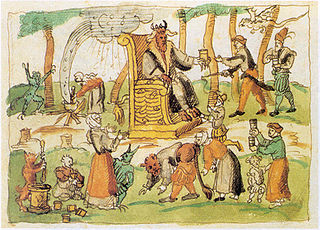
A Witches' Sabbath is a purported gathering of those believed to practice witchcraft and other rituals. The phrase became popular in the 20th century.
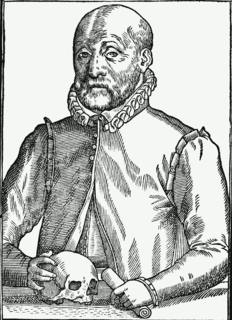
Johann Weyer or Johannes Wier was a Dutch physician, occultist and demonologist, disciple and follower of Heinrich Cornelius Agrippa.
Summis desiderantes affectibus, sometimes abbreviated to Summis desiderantes was a papal bull regarding witchcraft issued by Pope Innocent VIII on 5 December 1484.
Reginald Scot was an Englishman and Member of Parliament, the author of The Discoverie of Witchcraft, which was published in 1584. It was written against the belief in witches, to show that witchcraft did not exist. Part of its content exposes how feats of magic were done, and the book is often deemed the first textbook on conjuring.
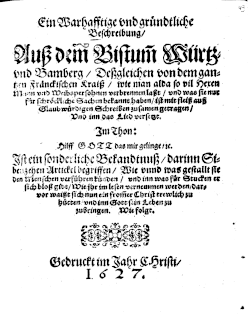
The Würzburg witch trials of 1625-1631, which took place in the self governing Catholic Prince-Bishopric of Würzburg in the Holy Roman Empire in present day Germany, is one of the biggest mass trials and mass executions ever seen in Europe, and one of the biggest witch trials in history.

Hans Christian Erik Midelfort, is C. Julian Bishko Professor Emeritus of History and Religious Studies at the University of Virginia. He is a specialist of the German Reformation and the history of Christianity in Early Modern Europe.
Georg Pictorius of Villingen was a physician and an author of the German Renaissance.
Prosecutions for the crime of witchcraft reached a highpoint from 1580 to 1630 during the Counter-Reformation and the European wars of religion, when an estimated 50,000 people were burned at the stake, of which roughly 80% were women, and most often over the age of 40.

The Witch trials of Fulda in Germany in the years from 1603 to 1606 resulted in the death of about 250 people. It belonged to the four largest witch trials in Germany alongside the Trier witch trials, the Würzburg witch trial, and the Bamberg witch trials. The persecutions were ordered by the Catholic Prince Bishop, a follower of the Counter-Reformation, and crypto-protestans were executed on charges of witchcraft.

The Witch Trials of Trier took place in the independent Catholic diocese of Trier in the Holy Roman Empire in present day Germany between 1581 and 1593, and were perhaps the largest documented witch trial in history in view of the executions. They formed one of the four largest witch trials in Germany alongside the Fulda witch trials, the Würzburg witch trial, and the Bamberg witch trials.
The Ralph Waldo Emerson Award is a non-fiction literary award given by the Phi Beta Kappa society, the oldest academic society of the United States, for books that have made the most significant contributions to the humanities. Albert William Levi won the first of these awards, in 1960.
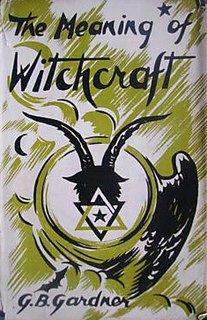
The Meaning of Witchcraft is a non-fiction book written by Gerald Gardner. Gardner, known to many in the modern sense as the "Father of Wicca", based the book around his experiences with the religion of Wicca and the New Forest Coven. It was first published in 1959, only after the British Parliament repealed the Witchcraft Act of 1735, and proved to be Gardner's final book. The Wicca religion as expounded by Gardner was focused on a goddess, identified with the night sky and with wild nature, and a horned god who represented the fertilizing powers of the natural world. It was organized into covens, through which members were initiated through three ascending degrees of competence and authority and which were governed by a high priestess, supported by a high priest. More historical context to the pagan practice of Wicca can be found in the book Wicca: History, Belief, and Community in Modern Pagan Witchcraft That book discusses Wiccan life, covering how and why people convert to Wicca; its denominations; its sociological demographics; its political beliefs, particularly in terms of environmentalist issues; the impact of anti-Wiccan persecution; the transmission of Wiccan and Pagan culture; and the history of academic analysis of Wicca.
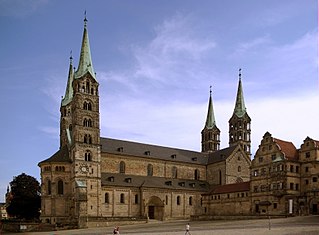
The Bamberg witch trials of 1626-1631, which took place in the self governing Catholic Prince-Bishopric of Bamberg in the Holy Roman Empire in present day Germany, is one of the biggest mass trials and mass executions ever seen in Europe, and one of the biggest witch trials in history.

Wiesensteig witch trial took place in Wiesensteig in Germany in 1562–1563. It led to the execution of 67 women for sorcery. This has been described as the first of the great witch trials of Germany and the starting point of the continuing European witch hunt. The trial inspired to the popular book : Of the tricks of Demons, which were printed in six expanded editions in Latin between 1562 and 1583 and translated to French in 1565. It was recorded in 1563 in a pamphlet called "True and Horrifying Deeds of 63 Witches".
Throughout the era of the European witch trials in the Early Modern period, from the 15th to the 18th century, there were protests against both the belief in witches and the trials. Even those protestors who believed in witchcraft were typically sceptical about its actual occurrence.
The Mergentheim witch trials took place in Mergentheim in Germany between 1628 and 1631. These witch trials resulted in the deaths of 126 people; there were 122 executions, and four died during torture. The trials belonged to the great wave of witch-hunting that took place in southwestern Germany during the Thirty Years' War. It is one of the best documented of the mass witch trials of southwestern Germany. Perhaps the best known victim of the Mergentheim witch trials was the innkeeper Thomas Schreiber, who had been vocal in opposition to the trials before his own arrest.
Thomas Schreiber was a German innkeeper executed for witchcraft. He was the perhaps best known victim of the Mergentheim witch trials, and became known for his opposition to the witch trials. His correspondence is preserved. His case gives an unusually detailed example of the mentality of a city in the midst of a mass witch trial.
Joseph Hansen was an influential German historian of the witchcraft persecutions, and an archivist in the city of Cologne, where at the age of 80 he was killed, along with his wife, by the bombs of World War II.

The witch trials in the Holy Roman Empire, composed of the areas of present-day Germany, Switzerland and Austria, were the most extensive in Europe and in the world, both to the extent of the witch trials as such as well as to the number of executions.
References
- ↑ Midelfort, H. C. Erik, Witch hunting in southwestern Germany 1562-1684: the social and intellectual foundations, U.P, Stanford, Calif, 1972
- Midelfort, H. C. Erik, Witch hunting in southwestern Germany 1562-1684: the social and intellectual foundations, U.P, Stanford, Calif, 1972
This article may be expanded with text translated from the corresponding article in German. (May 2017)Click [show] for important translation instructions.
|